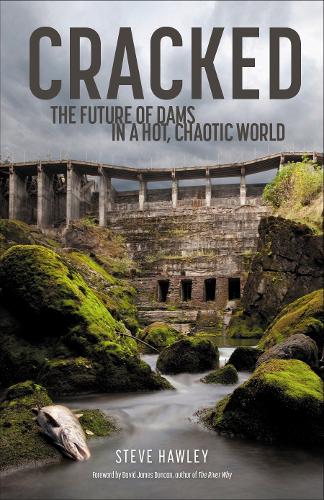
Cracked: The Future of Dams in a Hot, Crazy World
(Hardback)
Publishing Details
Cracked: The Future of Dams in a Hot, Crazy World
By (Author) Steven Hawley
Foreword by David James Duncan
Patagonia Books
Patagonia Books
7th September 2023
United States
Classifications
General
Non Fiction
333.914
Physical Properties
Hardback
320
Description
The ugly truthabout dams is about to be revealed.
During the first two decades of the twenty-first century, the whole messy truth about the legacy of last centurys big dam building binge has come to light. What started out as an arguably good government project has drifted oceans away from that original virtuous intent. Governments plugged the nations rivers in a misguided attempt to turn them into revenue streams. Water control projects main legacy will be one of needless ecological destruction, fostering a host of unnecessary injustices.
The estimated 800,000 dams in the world cant be blamed for destroying the earths entire biological inheritance, but they play an outsized role in that destruction.Cracked: The Future of Dams in a Hot, Crazy Worldis a kind of speed date with the history of water control -- its dams, diversions and canals, and just as importantly, the politics and power that evolved with them. Examples from the American West reveal that the costs of building and maintaining a sprawling water storage and delivery complex in an arid worldgrowing increasingly arid under the ravages of climate chaosis well beyond the benefits furnished. Success stories from Patagonia and the Blue Heart of Europe point to a possible future where rivers run free and the earth restores itself.
Reviews
Both troubling and encouraging, a well-told tale of environmental activism and citizen action.Kirkus ReviewsaboutRecovering a Lost River
"Hawleys thorough research makes a damning case for rethinking how to source water, and anecdotes about ecosystems that have flourished after dam removals strike an optimistic note about the road ahead. Environmentalists will be riveted." -- Publisher's Weekly
Dams are ineffective and an ecological and humanitarian hazard, contends journalist Hawley (Recovering a Lost River) in this impassioned expos. He surveys the environmental damage caused by dams alongside stories of people displaced and ill-served by their construction. Explaining how dams destabilize ecosystems, he tells how putting up dams in the Westlands Water District near Fresno, Calif., in the 1960s disoriented migrating salmon by disrupting river currents and poisoned bird populations after poor irrigation led to the buildup of toxic chemicals. Hawley argues that the purported benefits of hydroelectric damsgreen energy production and a steady water supplyare largely myths; the decomposition of organic flotsam that builds up in reservoirs produces methane at rates that can rival fossil fuel production, and as the globe heats up, evaporation will take an increasingly large cut of reservoir water. Highlighting the heartbreaking humanitarian consequences of dam construction, the author describes how the Bureau of Reclamation forced the Mandan, Hidatsa, and Arikara tribes off their ancestral land in North Dakota for a pittance of the tracts value, destroying their way of life. Hawleys thorough research makes a damning case for rethinking how to source water, and anecdotes about ecosystems that have flourished after dam removals strike an optimistic note about the road ahead. Environmentalists will be riveted. -- Publisher's Weekly
"Lavishly displayed color photographs help illustrate Hawleys narrative, which might motivate a nationwide rethinking of these extravagantly expensive, outdated systems." Alan Moores,BooklistStarred Review
"Environmental journalist Hawley, whoseRecovering a Lost River(2012) likely helped spur legislative action to remove four federal dams to resuscitate one of the great salmon rivers of the world, the Snake, here uses a wider lens to examine the dubious value of many of the other dams built worldwide in the last century. According to the author, those dams have decimated fish populations, undermined fragile ecosystems, inundated sacred grounds, created a massive methane footprint, cost outrageous public sums to build and maintain for the actual value they provide to farmers and the electrical grid, and threatened public safetysome 15,600 highhazard dams in the U.S. would cause significant loss of life if any failed. These dams have also lost more water to evaporation than theyve provided to the cities they were intended to serve. Hawley does an excellent job of laying out the history of dam building, especially in the arid American West; its failings; some recent successes in reopening rivers (the Elwah, for example); the mechanicsand grass-roots politickingof dam removal; and viable alternatives to dams, like underground storage of water and solar power. Lavishly displayed color photographs help illustrate Hawleys narrative, which might motivate a nationwide rethinking of these extravagantly expensive, outdated systems." Alan Moores,BooklistStarred Review
Author Bio
Steven Hawley is a writer and filmmaker from Hood River, Oregon. He is the writer and co-producer of an award-winning documentary, Dammed to Extinction (2019) and the author of Recovering a Lost River (Beacon Press, 2011.) Hes also a contributor at The Drake, Outlaw, and the Columbia Insight. David James Duncan is an American novelist and essayist, best known for his two bestselling novels, The River Why and The Brothers K. Both novels received the Pacific Northwest Booksellers award; The Brothers K was a New York Times Notable Book in 1992 and won a Best Books Award from the American Library Association.
